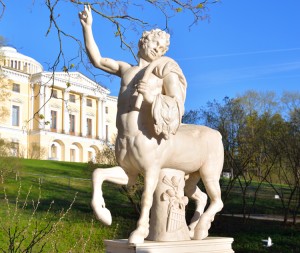Mythic Monday: the Quadrupedal Centaur
September 18, 2017
The word horseman is simple enough: in common speech, it means a person who is skilled in riding or taking care of horses. The term may conjure strikingly different images, however, for readers of religious texts, popular fiction of yesteryear, or ancient myths. The Christian Bible’s Book of Revelation tells of the Four Horsemen of the Apocalypse, who represent hardships that humans must endure before the end of the world. The American author Washington Irving told of a ghostly headless horseman who so frightens the schoolteacher Ichabod Crane that Crane flees Sleepy Hollow forever. But an even older story—a legend of ancient Greek mythology—described perhaps an even stranger kind of horse-man: the quadrupedal centaur. (A quadruped is an animal with four feet.)
The centaurs were mythological half-man, half-horse creatures that lived in the mountainous Thessaly region of northern Greece. Most depictions of the centaurs show them with a human torso atop the body of a horse. The centaurs were not known for their good manners, and not just for wearing their shoes indoors and munching up all your sugar cubes. The centaurs—their powers of reason overwhelmed by animal instincts—highly valued strong drink, fighting with branches, and other boisterous passions. At the wedding feast of King Pirithous of the Lapiths (the peace-loving people of Thessaly) and his bride, Hippodameia, the centaurs became drunk and tried to kidnap the Lapith women. A great melee followed, and the Lapiths finally drove away the centaurs. Lapith grandmothers thus gained veto power over wedding guest lists for generations to come.
Not all centaurs were uncivilized brutes, however. Chiron, perhaps the most well-known centaur, was wise and just and famous for his skill in medicine. Chiron was also a valued educator who listed Ajax, Aeneas, Achilles, Jason, and Perseus among his pupils.



